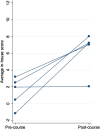Development and validation of a new assessment tool for suturing skills in medical students
- PMID: 29606802
- PMCID: PMC5871634
- DOI: 10.1007/s00238-017-1378-8
Development and validation of a new assessment tool for suturing skills in medical students
Abstract
Background: In recent years, emphasis has been put on that medical student should demonstrate pre-practice/pre-registration core procedural skills to ensure patient safety. Nonetheless, the formal teaching and training of basic suturing skills to medical students have received relatively little attention and there is no standard for what should be tested and how. The aim of this study was to develop and validate, using scientific methods, a tool for assessment of medical students' suturing skills, measuring both micro- and macrosurgical qualities.
Methods: A tool was constructed and content, construct, concurrent validity, and inter-rater, inter-item, inter-test reliability were tested. Three groups were included: students with no training in suturing skills, students who have had training, plastic surgery.
Results: The results show promising reliability and validity when assessing novice medical students' suturing skills.
Conclusions: Further studies are needed on implementation of the instrument. Moreover, how the instrument can be used to give formative feedback, evaluate if a required standard is met and for curriculum development needs further investigation.Level of Evidence: Not ratable.
Keywords: Assessment tool; Microsurgery; Plastic surgery; Surgical education; Suturing skills; Technical skills assessment; Undergraduate training.
Conflict of interest statement
Compliance with ethical standardsThe research did not receive any specific grant from funding agencies in the public, commercial, or not-for-profit sectors.Henriette Pisani Sundhagen, Stian Kreken Almeland, and Emma Hansson declare that they have no conflict of interest.The study protocol was reviewed by the Regional Committee for Medical and Health Research Ethics and it was concluded that Norwegian law on research ethics and medical research does not require an ethical permit for this type of study (2015/896, REK-vest). The Declaration of Helsinki was followed.All participants gave their written informed consent to participate.
Figures







References
LinkOut - more resources
Full Text Sources
Other Literature Sources
Miscellaneous
